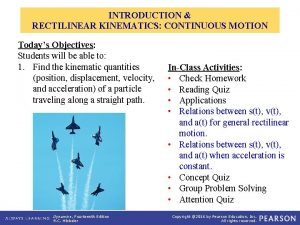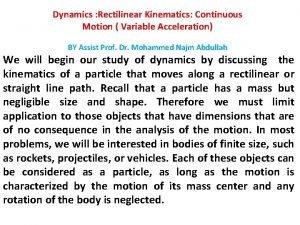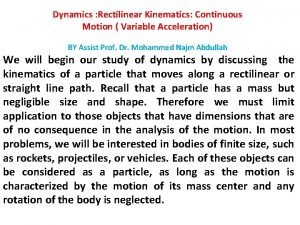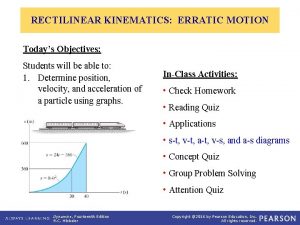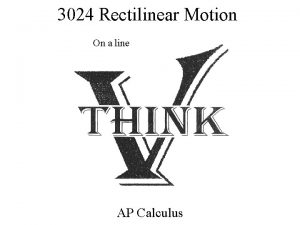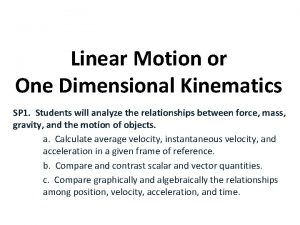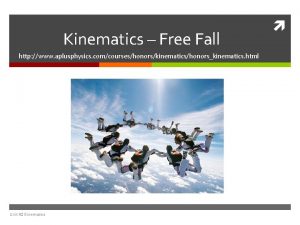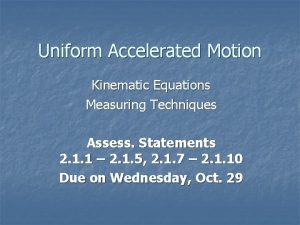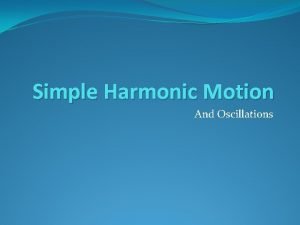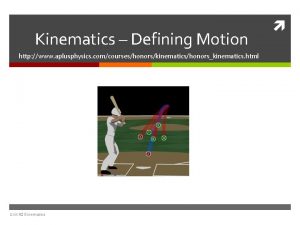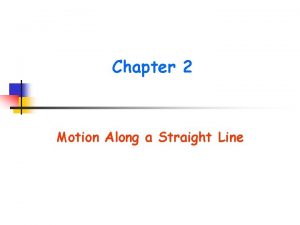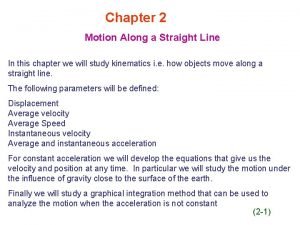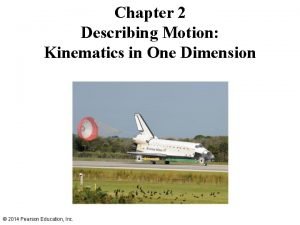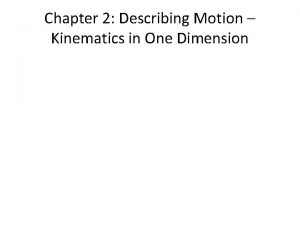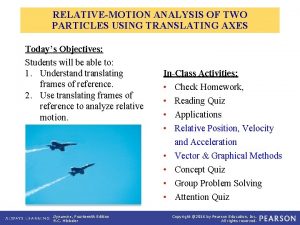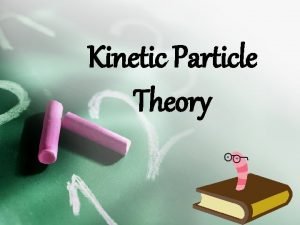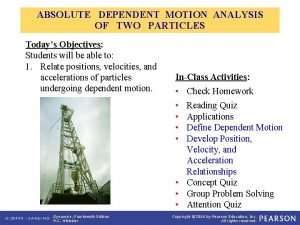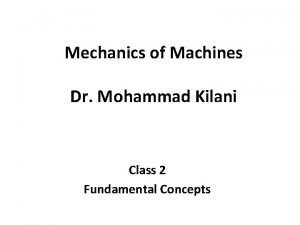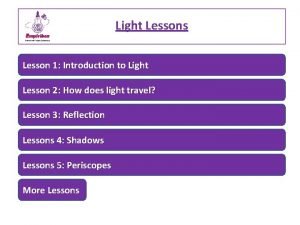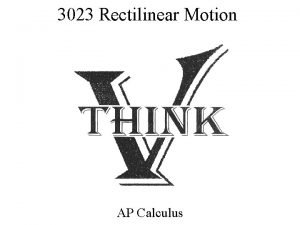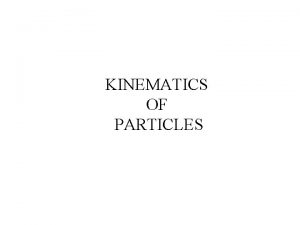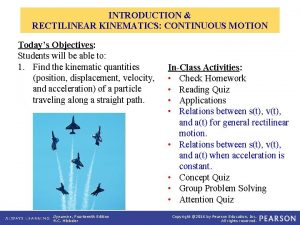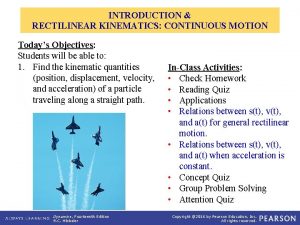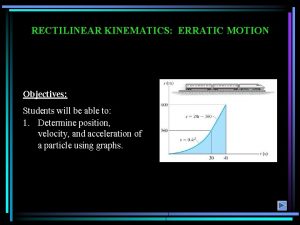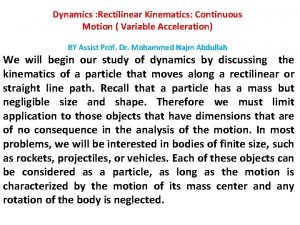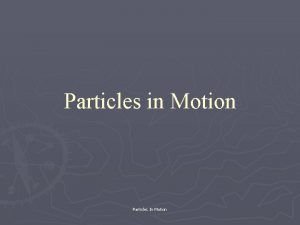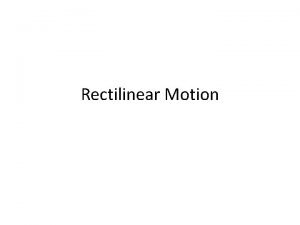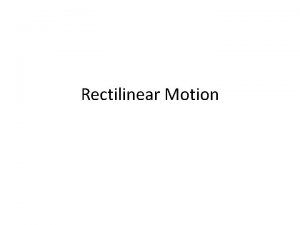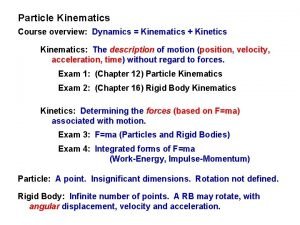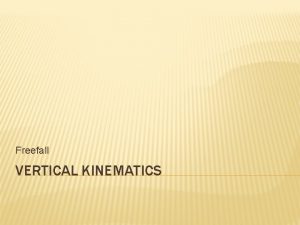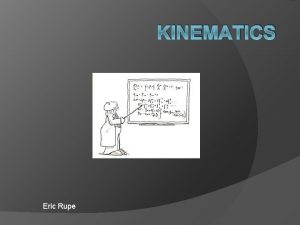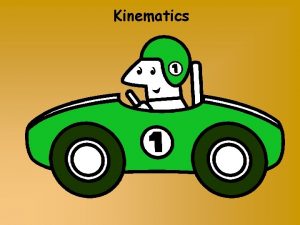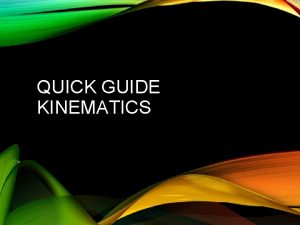Kinematics of Particles Rectilinear Motion Lesson 2 Sections



























- Slides: 27

Kinematics of Particles – Rectilinear Motion Lesson 2 - Sections 2/2 and 2/3 • Rectilinear Motion – Fundamental equations of motion from last class © D. J. Morrison, 2013 1

• Frequently we want to define the motion of the particle by expressing s in terms of t • Consider the following three cases: © D. J. Morrison, 2013 2

– Case I: Acceleration given in terms of t. For example: First, look for a fundamental equation that contains both a and t © D. J. Morrison, 2013 3

So, we start with Note we wrote the acceleration as a(t) to emphasize the fact that a is a function of t. Then: This gives us v as a function of time or v(t) © D. J. Morrison, 2013 4

But we want s in terms of t or So we must “transform” v(t) into s(t) © D. J. Morrison, 2013 5

Look for a fundamental equation that contains v, t, and s © D. J. Morrison, 2013 6

So, we start with Then: This gives us s as a function of time or s(t) © D. J. Morrison, 2013 7

This is what we wanted, s(t) But we already showed that: So: v(t) © D. J. Morrison, 2013 8

– Case II: Acceleration given in terms of s. For example: (Problem 2/40) First, look for a fundamental equation that contains both a and s © D. J. Morrison, 2013 9

So, we start with Rearranging terms Then This gives us v(s) © D. J. Morrison, 2013 10

Thus, we have But we want to get s(t) So we must “transform” v(s) into s(t) Look for a fundamental equation that contains v, t, and s © D. J. Morrison, 2013 11

So, we start with Then: This gives us what we wanted, s as a function of t or s(t) © D. J. Morrison, 2013 12

– Case III: Acceleration given in terms of v. For example: (Problem 2/40) First, look for a fundamental equation that contains both a and v © D. J. Morrison, 2013 13

So, we start with Then This gives us v(t) © D. J. Morrison, 2013 14

Then as for Case I, once we know v(t) we can find s(t) From We already showed that This gives us what we wanted, s as a function of t or s(t) © D. J. Morrison, 2013 15

• Special Case: Uniformly accelerated rectilinear motion (UARM) – ACCELERATION is CONSTANT - not a function of time © D. J. Morrison, 2013 16

Likewise But for UARM So © D. J. Morrison, 2013 17

Also Then © D. J. Morrison, 2013 18

– For uniformly accelerated rectilinear motion the following equations apply: REMEMBER, UARM MEANS ACCELERATION IS CONSTANT!!! © D. J. Morrison, 2013 19

Example Problem: L 2 -1 © D. J. Morrison, 2013 20

Example Problem: L 2 -1 Given: so= 3 m Find: s, v, and a, when t = 3 s © D. J. Morrison, 2013 21

Example Problem: L 2 -2 © D. J. Morrison, 2013 22

Example Problem: L 2 -2 Given: so= 3 m vo= 10 m/s Find: v(s), and v when s = 5 m and k = 0. 1 m-1 s-2 © D. J. Morrison, 2013 23

Example Problem: L 2 -3 © D. J. Morrison, 2013 24

Example Problem: L 2 -3 Given: a=1. 5 g = constant so= 0 vo= 0 Find: v and t when s = 30 km © D. J. Morrison, 2013 25

Example Problem: L 2 -4 © D. J. Morrison, 2013 26

Example Problem: L 2 -4 Given: a= 0. 4 g = constant vo= 0 so= 0 Find: s and t when v = 200 km/h © D. J. Morrison, 2013 27
 Rectilinear kinematics
Rectilinear kinematics Continuous motion example
Continuous motion example Rectilinear motion with variable acceleration
Rectilinear motion with variable acceleration Example of variable acceleration
Example of variable acceleration Rectilinear motion of particles
Rectilinear motion of particles Erratic motion examples
Erratic motion examples Aplusphysics kinematics-horizontal kinematics
Aplusphysics kinematics-horizontal kinematics Uniformly variable rectilinear motion
Uniformly variable rectilinear motion Rectilinear motion calculus
Rectilinear motion calculus What is negative velocity on a graph
What is negative velocity on a graph Galileo trick kinematics
Galileo trick kinematics Kinematic equations rearranged
Kinematic equations rearranged Kinematics of simple harmonic motion
Kinematics of simple harmonic motion Aplusphysics kinematics-free fall answers
Aplusphysics kinematics-free fall answers What is motion along a straight line
What is motion along a straight line Motion along a straight line definition
Motion along a straight line definition Describing motion kinematics in one dimension
Describing motion kinematics in one dimension Describing motion kinematics in one dimension
Describing motion kinematics in one dimension Formula for time of flight in projectile motion
Formula for time of flight in projectile motion Relative motion of two particles using translating axes
Relative motion of two particles using translating axes Particles in motion
Particles in motion Absolute dependent motion analysis of two particles
Absolute dependent motion analysis of two particles Motion of particles in solids, liquids and gases
Motion of particles in solids, liquids and gases Lesson 4 gravity and motion lesson review
Lesson 4 gravity and motion lesson review Perimeter of rectilinear shapes
Perimeter of rectilinear shapes General plane motion
General plane motion Does light travel in a straight line
Does light travel in a straight line Rectilinear distance formula
Rectilinear distance formula
